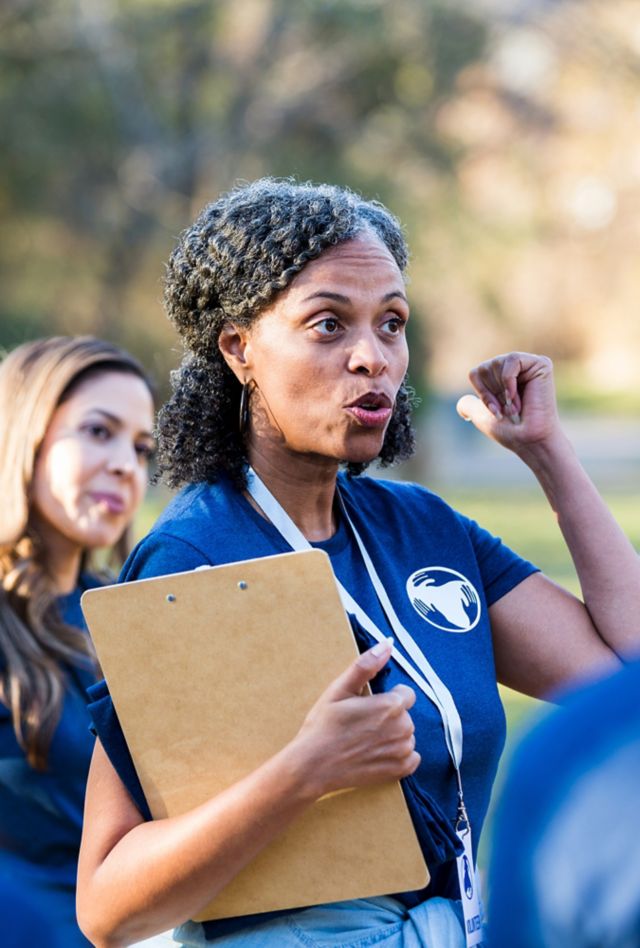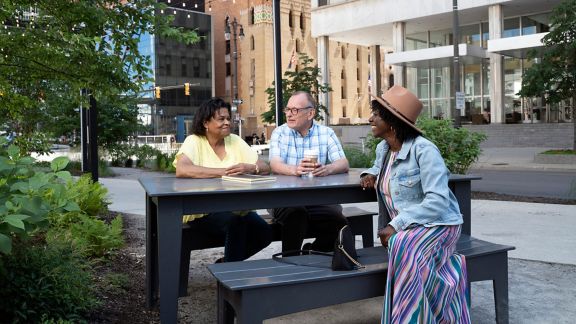Putting the Community-Engaged Research Framework into Practice

For inquiries, email:
October 2025
NORC developed the Community-Engaged Research (CEnR) Framework in 2023 to describe our approach to community-engaged research. NORC then developed the Toolkit for Putting the CEnR Framework into Practice, which provides a practical guide for researchers to use the Framework. The toolkit includes tools, tips, and additional resources to implement the CEnR Framework principles and strategies.
This webpage provides an executive summary of the toolkit, summarizing actionable strategies for each phase of the research process listed within the CEnR framework. We use the terms “research(ers)” and “study” throughout but note that the Framework and the Toolkit apply to research and program evaluation.
PHASE 1
Establish Shared Governance Structure
Strategy 1.1: Identify and Engage Community Partners
- Identify individuals, organizations, and other entities in the community of interest. Attend events, leverage personal and professional networks, and conduct a scan to identify local organizations and trusted community leaders.
- Develop and implement an engagement plan. Articulate a clear purpose, approach, and timeline for engagement. Conduct an introductory meeting to identify and understand each partner’s strengths, assets, and interests. Continue follow ups and engagement at regular intervals.
Strategy 1.2: Determine Nature and Scope of the Partnership
- Work with community members to define their “community.” Teams can define community in a myriad of ways, including based on common characteristics or links by social ties, perspectives, identities, residence, or interests.
- Establish ground rules for the partnership. Determine mode and frequency of communication with partners, compensation structure, and logistics of meeting coordination and scheduling. Discuss and address barriers to engagement (e.g., concerns about time commitment or staff skills, limited capacity, limited literacy or language, barriers with transportation or childcare).
- Define the scope of the partnership. Develop partnership arrangements, for example, memoranda of understanding, based on agreed upon roles and responsibilities. Specify data ownership and outline plans for sustainability.
- Ensure the research and partnership team represents the community. Avoid tokenism, i.e., do not include researchers or community members on a team simply as figureheads who will have no actual power or voice within the team.
TOOL: QUESTIONS TO CONSIDER
Developing an Engagement Plan
- What is the purpose of the partnership? What are each partner’s guiding principles and objectives for partnerships?
- What are unique areas of expertise each partner has or is looking to expand?
- What areas of collaboration is each partner interested in? What is the history of collaboration, challenges, and lessons learned?
- How is each partner / will each partner work with the community? How could the partnership advance community interests?
- How will each partner engage with each other and with the research?
- What is the timeline for this engagement? What are next steps?
Strategy 1.3: Establish a Shared Governance Structure
- Determine where the study is on the community-engaged research continuum and understand its implications for how to structure the partnership (See Appendix A for a Decision Tree Tool).
- Implement a governance structure. This can include naming community co-investigators or establishing a community advisory board (CAB) or steering committee (See Appendix B for Planning Framework).
PHASE 2
Define and Frame Research Questions and Objectives
Strategy 2.1: Understand Community Needs, Strengths, and Interests
- Conduct an assessment to understand community interests, knowledge, and needs. Conduct site visits, interviews, focus groups, surveys, windshield and walking surveys, and/or document reviews to assess community need. Review existing data, community archives, histories, and materials based on how local individuals and organizations have recorded their own stories.
- Affirm community strengths. Conduct Community Asset Mapping and SWOT (Strengths, Weaknesses, Opportunities, Threats) analyses to identify strengths and opportunities.
- Self-evaluate and self-reflect. Examine biases, acknowledge and shift power imbalances and take accountability. Acknowledge and interrogate (although not necessarily discard) expert knowledge when it conflicts with community opinions and insights.
Strategy 2.2: Develop Research Questions that Reflect the Interests, Needs, and Values of Communities
- Define research objectives and develop research questions. Engage in intentional dialogue, collect background data (see Strategy 2.1), and review documents related to the topic of interest. Balance knowledge generation with advancing local interests.
- Reconcile discordance in partner objectives. Align funder and researcher interests with community needs. Build consensus around the key research questions and objectives.
- Garner community buy-in early and often. Engage grassroots organizations and community leaders beyond those actively participating as partners. Share one-pagers or other materials that provide an overview of the research. Continuously offer in person and/or virtual community forums, listening sessions, and other avenues for continued and bidirectional feedback and information sharing.
TOOL: QUESTIONS TO CONSIDER
Defining Research Objectives
- How does the community view the topic and why?
- What language do communities use to discuss the topic?
- Who does the research affect? Which groups are more or less affected by the issue?
- What are the root causes of the issues? How does the historical context of the community influence the topic?
- What value does the research bring to the community? How will the research help advance community interests (e.g., inform development or enhancement of programs, services, policies)?
Source: Child Trends
Strategy 2.3: Identify and Collaboratively Pursue Funding
- Identify and apply for funding opportunities. Develop partnerships early and prepare responses to funding solicitations together, when possible. Collaboratively reach out to potential funders to propose ideas. Create processes for continuous sharing of opportunities for future funding, even after the study ends.
PHASE 3
Design Study Methods and Adapt Instruments
Strategy 3.1: Collaboratively Select a Study Design That Is Responsive to Community Context
- Select study designs that community partners have found successful. For example, use mixed methods approaches that capture not just the extent of a belief, opinion, or need, but also individual voices, stories, and context to explain nuances and trends. Beyond surveys, interviews, and focus groups, consider other research methods like photovoice, ethnographic studies, social listening, community mapping, or storytelling.
- Develop a sampling frame based on community context. Consider community-based, venue-based, respondent-driven sampling, and hybrid approaches in addition to traditional random and address-based sampling. Assess strategies to reach sufficient community and/or population samples. Ideally, design a sampling frame that facilitates data disaggregation to reveal differences that may exist for some individuals and groups within particular contexts.
TOOL: QUESTIONS TO CONSIDER
Selecting Study Methodologies
- Can the topic(s) be studied quantitatively, qualitatively, or both?
- Who does each potential study approach include? Who does it exclude?
- How do community members share information? Consider literacy and language and their implications for the study approach.
- What kinds of leadership exist in the community? Will entry into the community be helped or hindered by partnership with specific leaders?
- What capacities exist for research? What capacities could be built that stay in the community afterwards? What capacities does the research team need to build internally to better support community partners?
Strategy 3.2: Collaboratively Develop Data Collection Instruments and Protocols
- Develop and assess data collection instruments to ensure responsiveness to community culture and norms. Include strengths-based measures that assess community competence, resources, promise, and resiliency. Incorporate frameworks that acknowledge the multiple levels of influence (i.e., individual, interpersonal, community, societal) that can affect opinions and behaviors. Consider the language needs of the community and translate data collection instruments and research materials, and use interpreters as needed.
- Establish protocols that reflect community context. Consider where recruitment and data collection take place, by whom, and when, and researcher and community partner capacity to support recruitment and data collection. Develop supplemental materials like job aids, adverse events protocols (e.g., for when a risky situation arises), and troubleshooting guides. Develop resources that provide participants with additional supports, especially if the research is about a sensitive topic.
- Consider the amount and mode of incentive payments for research participants. Determine incentive amounts and types based on burden estimates, accessibility, and preferences. Consider additional ways of alleviating burden of participation (e.g., offering child care or making the research environment child friendly, providing transportation supports, offering tablets for individuals that lack access to the Internet).
Strategy 3.3: Consider the Implications of Institutional Review Boards (IRB) and Informed Consent
- Develop informed consent processes and forms that are responsive to a group’s norms, and accessible to people with different abilities. Consider literacy and language accessibility. Assess the need for supplemental materials that reinforce understanding of the informed consent process (e.g., FAQs) and tools that assess comprehension of informed consent. Be intentional and transparent in describing privacy protection processes.
- Develop and submit IRB application. Determine whether community partners need additional IRB review or approval (e.g., Tribal IRB, see callout box) or if they can rely on the research team’s IRB for data collection.
- Develop a data management plan for protecting data and personally identifiable information (PII). Ensure all systems (e.g., computers, tablets, data storage cabinets) meet requirements and standards for data security and align with data use agreements requirements. Offer tablets, secure storage boxes, or other alternatives to data collectors, if needed, to ensure protection. Establish additional protections like non-disclosure agreements to protect PII when needed.
PHASE 4
Implement Study and Collect Data
Strategy 4.1: Recruit a Community-Based Workforce for Data Collection
- Identify and recruit community members as data collectors. Work with community partners to identify individuals. Prepare a one-pager that defines the role, expectations, compensation structure, and timeline. Establish a process for interviewing potential data collectors. Incorporate them early in the process to inform the study design and research questions.
- Train a community-based workforce. Ensure all team members receive training, including human subjects training and study-specific training. Determine the appropriate length, mode, type, and timing of training and accessibility needs. Use adult learning principles and offer additional supports (e.g., office hours, supplemental training). Ensure all members receive documentation of their training (e.g., certificates of completion) to further their professional development.
RESOURCES
Community Human Subjects Training
Community partners have varying levels of experience with research. Some research, ethics, and compliance human subjects training programs are designed for professionally trained researchers. Consider alternative options like CIRTification: Community Involvement in Research Training, a human research protections training program designed especially for community partners.
Strategy 4.2: Implement Community-Centered Data Collection Protocols
- Meet potential participants “where they are” and ensure data collection is appropriate and relevant for the intended group. Coordinate with trusted partners to meet research participants on their terms and in their preferred modes of communication.
- Provide data collectors with technical assistance and support. Identify clear points of contact and methods for communication. Develop troubleshooting protocols that are accessible and readily available. Establish back up technology and other support in case of malfunction during implementation. Establish processes and platforms for sharing best practices across teams throughout data collection.
- Monitor data collection for privacy protection and to track progress. Have regular check-ins and reporting of progress. Develop and implement quality assurance processes to ensure data collection is systematic. Touch base regularly about how data storage is occurring and troubleshoot any issues.
- Implement data collection closeout procedures. Ensure every partner is systematically closing out data collection per study requirements. Hold debriefs to discuss the experience, challenges, successes, and lessons learned to inform future efforts.
TOOL: QUESTIONS TO CONSIDER
Debriefing from Data Collection
- Knowing what you know now, what would you have wanted to be trained in? Were there any training topics you’d like to have covered thoroughly? What parts of the training were most and least valuable to you?
- What worked well and what didn’t work well about [gaining cooperation; recruitment; data collection process; data storage; data reporting; paying incentives]? If we did the study again, what else should be considered?
- What were the pros and cons of conducting this study using [study approach]? What were considerations for specific populations?
- To what extent were [job aids; participant resources; adverse events protocols] useful? What was missing that would have been helpful?
- What surprised you about the process? What was the best and what was the hardest part about working on this study?
- What made you a successful [interviewer/data collector/recruiter]?
- What would you like to see happen with the results of this data collection?
- Overall, what does this study mean for you? For your community?
PHASE 5
Analyze Data and Justify Findings and Conclusions
Strategy 5.1: Conduct Participatory Analysis and Data Interpretation
- Analyze data in partnership with community members and partners. Doing this will facilitate identifying and interpreting the most meaningful results. Invite people to discussions about how to best analyze and interpret qualitative and quantitative data. Hold data parties and engage community in coding and categorizing data and leading sensemaking, analysis, with researchers.
RESOURCES
Data Parties as a Tool for Participatory Analysis
- A Method for Participatory Analysis and Sense-Making in Virtual Spaces
- Data Placemats: A 3-Step Process for Increasing Data Use
- Data Walks: An Innovative Way to Share Data with Communities
- Stephanie Evergreen for data engagement tools
- Dabbling in the Data: A Hands-On Guide to Participatory Data Analysis
- Where possible, disaggregate data. Conduct analyses that can reveal and highlight specific differences that may exist for some individuals and groups within particular contexts.
Strategy 5.2: Promote Community Ownership of Its Own Data
- Early on, have discussions to determine who will own the study data. If funders cannot grant access and/or ownership of the data, consider alternatives such as sharing infographics and/or other easily interpretable results with community (e.g., data tables).
RESOURCES
Promoting Community Data Ownership
GWI Civic Data Trusts – What are They and Why describes civic data trusts that give a trustee or a group of trustees authority to make decisions about how a data asset can be used on behalf of a community.
PHASE 6
Ensure Use of Research Findings and Share Lessons Learned
Strategy 6.1: Tailor Dissemination of Findings to Community Needs
- Collaboratively determine key audiences and dissemination approaches. Determine what will be most helpful to share with community members and partners. Establish a plan for dissemination of research updates and findings back to the community.
- Tailor dissemination products to community context. Consider dissemination products beyond academic publications and reports. Communities may benefit instead from community reports, fact sheets, infographics, community events, webinars, or other dissemination approaches. Tailor the dissemination in type and format of the product, language, accessibility, forum, etc. Generate any recommendations included in reporting of findings through an inclusive process that involves community members. Highlight the role of community involvement in the research in all reporting.
- Develop feedback mechanisms to share data back to communities under inquiry. This may include sharing raw data files, or topline results of data analysis. Adequately explain the limitations of research, data, and findings.
Strategy 6.2: Use First-Person Language in Reporting
- Words matter, so be intentional about carefully selecting language. Ensure that findings acknowledge the structural issues contributing to individuals’ behaviors or experiences and provide contextual information that explains the data.
RESOURCES
Person-First Language
PHASE 7
Foster Sustainability of Partnership and Research
Strategy 7.1: Establish Group Norms for Sustainability at Study Outset
- Create group norms for research conduct that advance sustainability. This includes having “group rules” or formal memorandums with expectations for each partner and the relationship.
- Regularly discuss strategies and avenues for sustainability with community partners. Meet regularly and establish open communication channels. Use lessons learned from evaluations of the partnership or research effort to adapt existing strategies and inform future efforts.
- Share resources that may be of interest to each partner. Enhance partner capacity by securing a wide range of resources, enhancing skills, expertise, and visibility, and advocating for partner needs. Offer letters of support or recommendation, certificates of completion, or other resources and supports.
- Engage with partners outside of a specific study or topic area. Hold check-ins outside of the research context to build rapport. Attend local events and community forums, webinars, or other events. Recommend ways to work together on other studies outside of the study period.
Strategy 7.2: Track Funding Opportunities for Additional Partnership
- Maintain processes for identifying funding opportunities beyond the end of the study. Seek opportunities to secure resources to sustain the partnership core, not just the research. Support each other in identifying resources and other opportunities to enhance skills related to seeking and applying for funding opportunities.
- Seek collaborative opportunities for moving forward recommendations and findings from the study. Include community member recommendations for future research or funding in final reports. Disseminate results to policymakers and seek ways to implement recommendations. Monitor funding opportunities that may expand partnership.
Conclusion
Based on existing frameworks, literature, theory, and NORC scientists’ experiences, this Toolkit offers researchers strategies, questions, and tools to strategically engage community throughout the research process. Community-engaged research develops and nurtures researcher-community partnerships, takes time, effort, intentionality, and adequate resources. Involving community in research processes requires and engenders trust, increases credibility of the research, and minimizes barriers to community participation in research.
Appendix
Appendix A: Decision Tree

Appendix B: Planning Framework
Community-Engaged Research Approaches, by Research Phase
Research Phase | Community Informed Community as advisor | Community Involved Community as collaborator | Shared Leadership Community as equal partner | Community Led Community as leader |
|---|---|---|---|---|
| 1: Establish Shared Governance Structure | Researcher-led governance structure. Researchers direct study; community advises (e.g., onetime input, no or limited decision-making control) | Researchers direct study and make final decisions, but have consistent community input, e.g., community advisory board. | Both community and researchers share decision-making authority (e.g., both researcher and community co-principal investigators; steering committee comprised of both researchers and community). | Community drives study, sets timelines, and makes final decisions with some researcher support or input |
| 2: Define and Frame Research Questions and Objectives | Researchers define research questions and objectives with some community input | Researchers define research questions and objectives in collaboration with community | Community and researchers unanimously define research questions and objectives | Community defines research question |
| 3: Design Study Methods and Adapt Instrumentation | Researchers define study methods and develop tools with some community input | Community reviews and gives input on data collection strategies, tools; facilitate connections | Community and researchers together determine methods and co-create tools | Community determines approach, creates tools with some researcher review and input |
| 4: Implement the Study and Collect the Data | Researchers conduct data collection | Researchers conduct data collection with help of community | Community members and researchers jointly conduct data collection (or jointly make decisions about who collects data) | Community members conduct data collection (or makes decision about who collects data) |
| 5: Analyze Data and Justify Findings and Conclusions | Researchers develop analysis measures and tools and analyze data with some community input | Researchers analyze data. Community reviews analysis tools, provides context or interpretation of findings | Community participates in data analysis, raises new questions, interprets meaning | Community leads analysis, raises new questions, interprets meaning |
| 6: Ensure Use of Research Findings and Share Lessons Learned | Community members review and provide some feedback to drafts and researchers reconcile the feedback, may advise on dissemination strategies and participate in sharing of results or lessons learned | Community provides feedback and contributes to drafts and interpretation of findings, share ideas on dissemination, are acknowledged in reports, publications, shared panel discussions, presentations, etc. | Community and researchers together develop recommendations, decide best modes for reporting, co-present findings, determine key audiences, share information in their networks, etc. | Community writes reports or develop other materials or approaches for reporting Community decides audience(s); presents findings |
| 7: Foster Sustainability of Partnerships and Research | Community members may take part in other studies in similar roles | Team discusses sustainability of partnership throughout and defines continuing relationships before the study ends | Sustainability is established as part of the shared leadership structure. Team explores continuous collaboration opportunities. | Community decides the needs for sustainability and guides the expansion or continuation of the collaboration with the researchers. |
Developed by Petry Ubri, Sabrina Avripas, and Anmol Sanghera as a product of internal NORC funding. Source: Adapted based on ATSDR Principles of Community Engagement, CRE Framework, and the Wilder Planning Framework for Involving Community Members in Evaluation.
Acknowledgements
NORC developed the Toolkit for Putting the Community-Engaged Research Framework into Practice through a cross-departmental workgroup of NORC staff with internal NORC funding, including funding from the Public Health Department.
The authors would like to thank the following individuals:
- External reviewers: Doris Mukangu, President & CEO of Amani Women Center and Phoebe Nelms Health IT Division Associate Project Director, National Center for Primary Care, Morehouse School of Medicine.
- NORC reviewers: James Iveniuk, Jocelyn Wilder, Vince Welch, and Tiaira Porter-Beall.
- Working group members: Chandria Jones, James Iveniuk, Jocelyn Wilder, and Stefan Vogler for meeting regularly, conducting consensus-building exercise around development of the Framework and providing support and review of the toolkit.
Suggested Citation
Ubri, P., Sanghera, A., Avripas, S., Chavez, A., Ferrell, K. and Johnson-Turbes, A. (202). Putting the Community-Engaged Research Framework into Practice: An Executive Summary. © 2025 NORC, All Rights Reserved.
Reproduction of this work for commercial purposes and reproduction and/or input of this work into generative artificial intelligence tools are prohibited.
About NORC
NORC at the University of Chicago conducts research and analysis that decision-makers trust. As a nonpartisan research organization and a pioneer in measuring and understanding the world, we have studied almost every aspect of the human experience and every major news event for more than eight decades. Today, we partner with government, corporate, and nonprofit clients around the world to provide the objectivity and expertise necessary to inform the critical decisions facing society.






